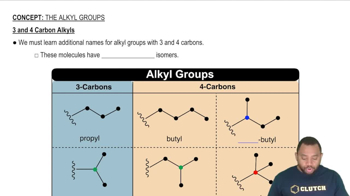Ch.21 - Nuclear Chemistry

Brown15th EditionChemistry: The Central ScienceISBN: 9780137542970Not the one you use?Change textbook
Chapter 21, Problem 90
Charcoal samples from Stonehenge in England were burned in O2, and the resultant CO2 gas bubbled into a solution of Ca(OH)2 (limewater), resulting in the precipitation of CaCO3. The CaCO3 was removed by filtration and dried. A 788-mg sample of the CaCO3 had a radioactivity of 1.5 × 10^-2 Bq due to carbon-14. By comparison, living organisms undergo 15.3 disintegrations per minute per gram of carbon. Using the half-life of carbon-14, 5700 years, calculate the age of the charcoal sample.
 Verified step by step guidance
Verified step by step guidance1
Step 1: Calculate the disintegrations per minute (dpm) for the 788 mg sample of CaCO3. Convert the radioactivity from Bq to dpm using the conversion factor 1 Bq = 1 disintegration per second, and then multiply by 60 to convert to disintegrations per minute.
Step 2: Determine the amount of carbon in the 788 mg sample of CaCO3. Use the molar mass of CaCO3 (100.09 g/mol) to find the moles of CaCO3, and then use the molar ratio to find the moles of carbon. Convert this to grams of carbon.
Step 3: Calculate the specific activity of the carbon in the sample in terms of disintegrations per minute per gram of carbon. Divide the dpm calculated in Step 1 by the grams of carbon found in Step 2.
Step 4: Compare the specific activity of the sample to that of living organisms (15.3 dpm/g). Use the ratio of these activities to determine the fraction of carbon-14 remaining in the sample.
Step 5: Use the decay formula N(t) = N0 * (1/2)^(t/T) where N(t) is the remaining fraction of carbon-14, N0 is the initial fraction (1 for living organisms), t is the time elapsed, and T is the half-life of carbon-14 (5700 years). Solve for t to find the age of the charcoal sample.
Key Concepts
Here are the essential concepts you must grasp in order to answer the question correctly.
Radioactive Decay
Radioactive decay is the process by which unstable atomic nuclei lose energy by emitting radiation. This decay occurs at a predictable rate characterized by the half-life, which is the time required for half of the radioactive atoms in a sample to decay. In this context, carbon-14 decays into nitrogen-14, and its half-life of 5700 years is crucial for determining the age of the charcoal sample.
Recommended video:
Guided course

Rate of Radioactive Decay
Carbon Dating
Carbon dating, or radiocarbon dating, is a method used to determine the age of organic materials by measuring the amount of carbon-14 they contain. Living organisms continuously exchange carbon with their environment, maintaining a constant ratio of carbon-14 to carbon-12. Upon death, this exchange stops, and the carbon-14 begins to decay, allowing scientists to estimate the time since the organism's death based on the remaining carbon-14.
Recommended video:
Guided course

3 and 4 Carbon Alkyls
Precipitation Reaction
A precipitation reaction occurs when two soluble substances react to form an insoluble product, known as a precipitate. In this scenario, the CO2 produced from burning charcoal reacts with Ca(OH)2 in limewater to form CaCO3, which precipitates out of the solution. Understanding this reaction is essential for grasping how the charcoal's carbon content was quantified through the formation of solid calcium carbonate.
Recommended video:
Guided course

Selective Precipitation
Related Practice
